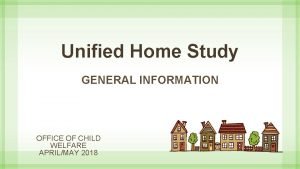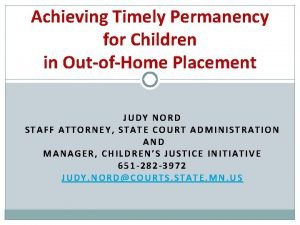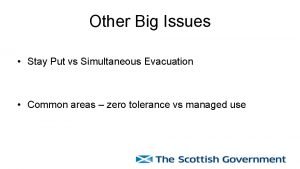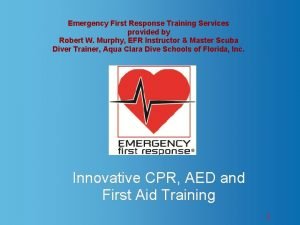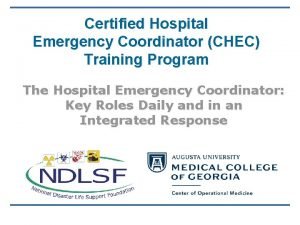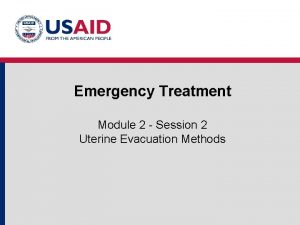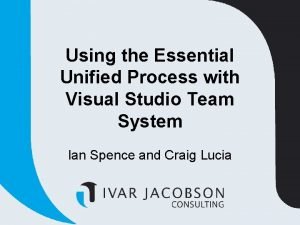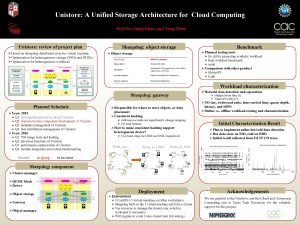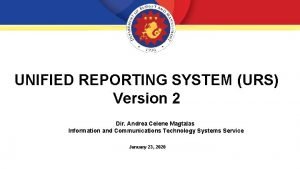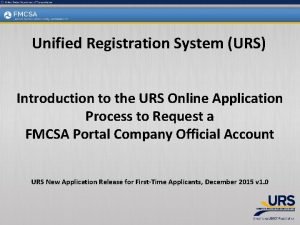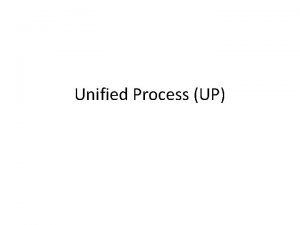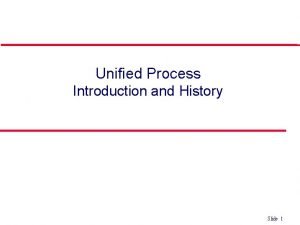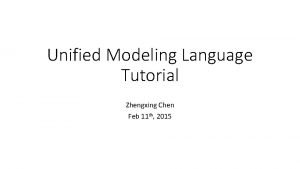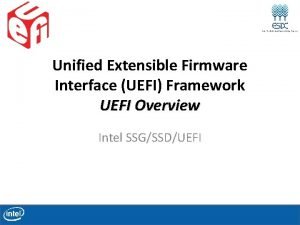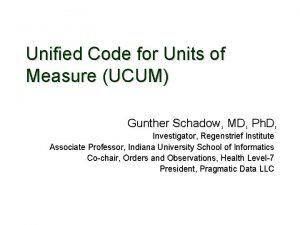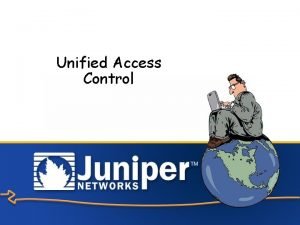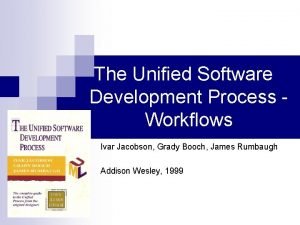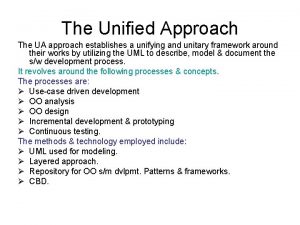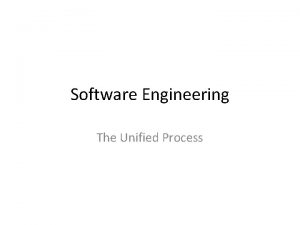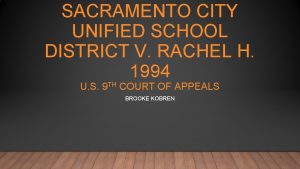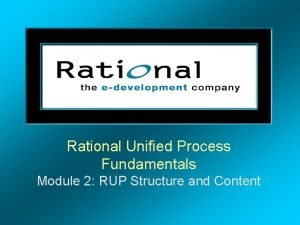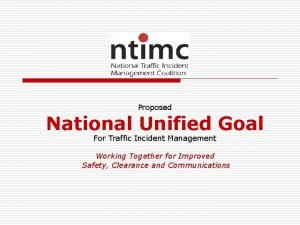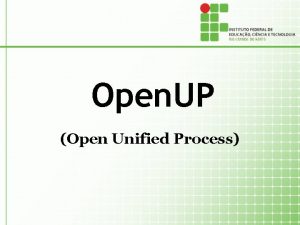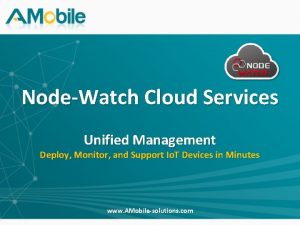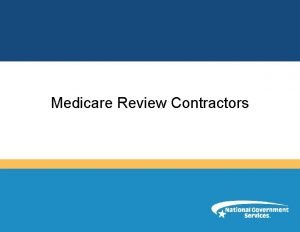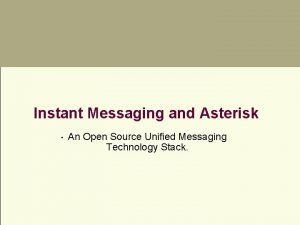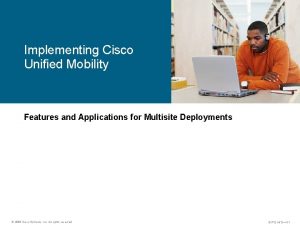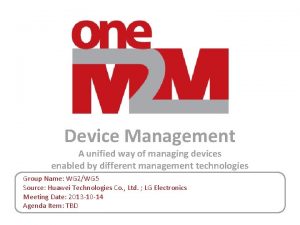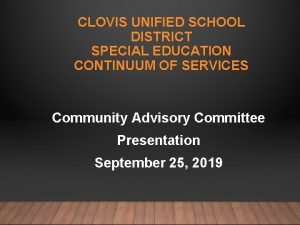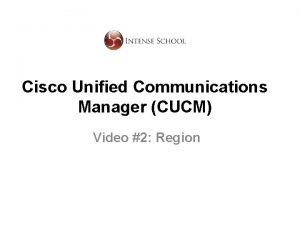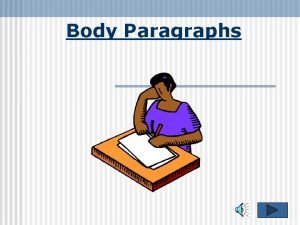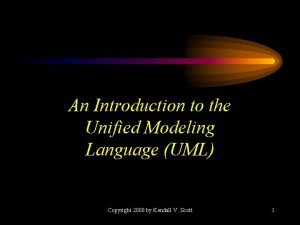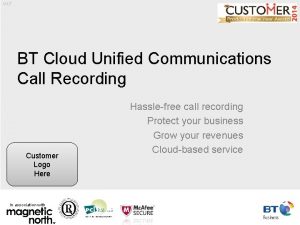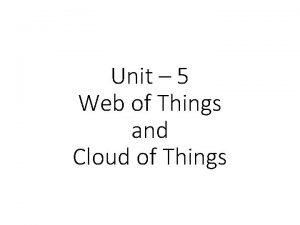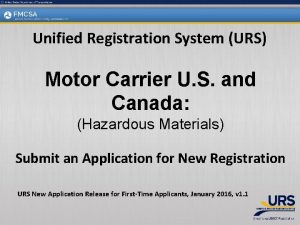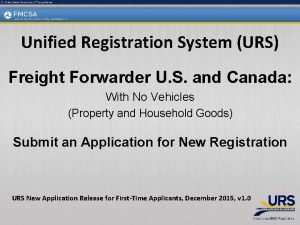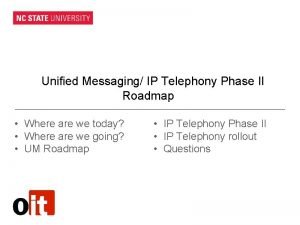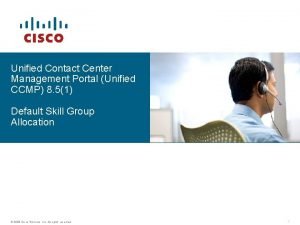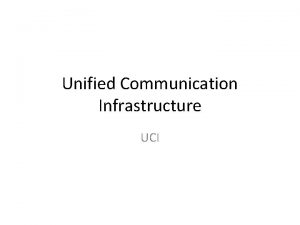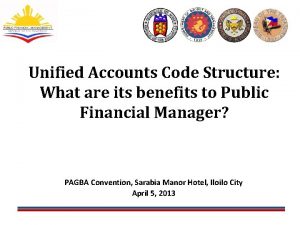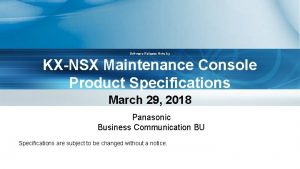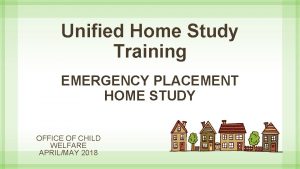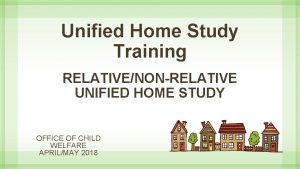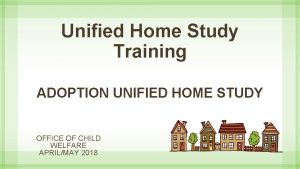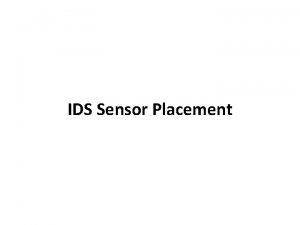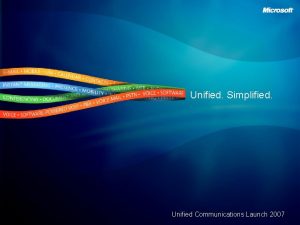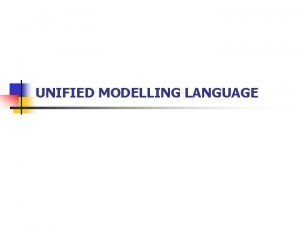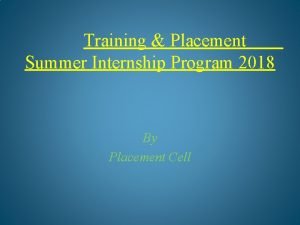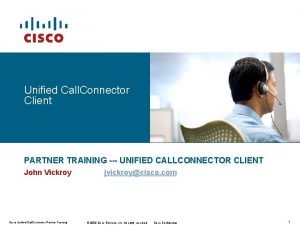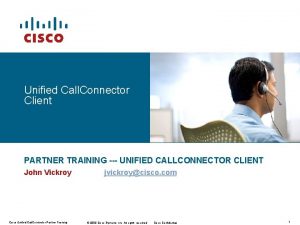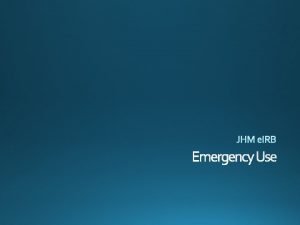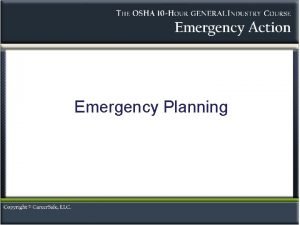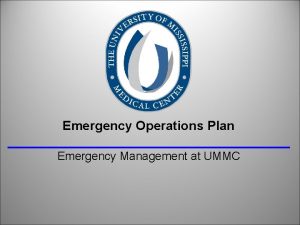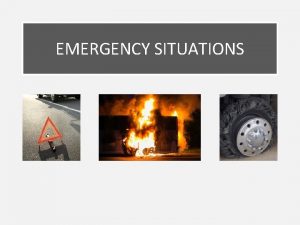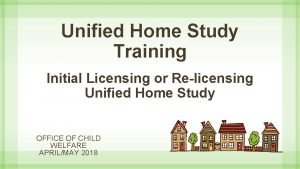Unified Home Study Training EMERGENCY PLACEMENT HOME STUDY






































































- Slides: 70

Unified Home Study Training EMERGENCY PLACEMENT HOME STUDY OFFICE OF CHILD WELFARE APRIL/MAY 2018

Learning Objectives Identify what information needs to be gathered and assessed in an Emergency Placement Home Study for a relative or non-relative placement. Demonstrate how to gather the necessary information for the Emergency Placement Home Study. Demonstrate how to document an Emergency Placement Home Study using FSFN. Unified Home Study 2. 2

Emergency Placements A removal of a child may occur at any hour day or night. This means CPIs are making placements where exigent circumstances exist. Unified Home Study 2. 3 Exigent circumstances, as defined in 65 C-30. 01(42), F. A. C. , are situations where it is anticipated that a child will be placed with a relative or non-relative within 72 hours.

Information Gathering Unified Home Study 2. 4 Gather as much information as possible. Gather caregiver’s interest and demographic information. Assess the level of care a child needs via the Placement Assessment. Identify and evaluate potential caregivers.

Demographic Information FSFN Tutorial Unified Home Study 2. 5

Demographic Information CPIs must gather demographic information on all household members and adult visitors to the home who provide care of the child outside of the caregiver’s ability to provide sight and sound supervision. Unified Home Study 2. 6

UHS Demographics tab: FSFN Screen s Unified Home Study 2. 7

UHS Demographics tab: FSFN Screen s Unified Home Study 2. 8

UHS Demographics tab: FSFN Screen s Unified Home Study 2. 9

UHS Demographics tab: FSFN Screen s Unified Home Study 2. 10

Background Checks FSFN Tutorial Unified Home Study 2. 11

Background Checks CPIs must obtain and assess background checks of all household members over the age of twelve, and frequent visitors over the age of 18 who provide sight and sound supervision. Telephone FSFN CIU Unified Home Study 2. 12

Background Checks, con’t. Abuse/ neglect record checks Local criminal/ probation checks Juvenile Justice information FCIC/ sexual predator NCIC Fingerprint submission Unified Home Study 2. 13

Analysis of Background Checks A thorough review and analysis of all of the background information gathered provides CPIs with the insight needed in order to ensure that the BEST possible placement is made for the child. When reviewing the criminal, abuse, and/or neglect records obtained, CPIs must assess for patterns of criminal behavior that may place the child in danger. Unified Home Study 2. 14

Disqualifiers While performing background checks, Child Welfare Professionals may find information that automatically disqualifies a person from being a placement candidate. Unified Home Study 2. 15

Disqualifiers, con’t. Offenses that disqualify a person include: Child abuse, abandonment, or neglect Child pornography or other felony involving a child Domestic violence Homicide, sexual battery, or other felony involving violence Unified Home Study 2. 16

Disqualifiers, con’t. Children cannot be placed with a person who has been convicted of a felony, within the last five years, within the following categories: A drug-related offense Assault Battery Unified Home Study 2. 17 Resisting arrest with violence

Documentation Within FSFN, CPIs must document the records obtained and their thorough analysis of the background check results within the Background Check Information page. Unified Home Study 2. 18

Prior Intakes Investigations/Referrals: FSFN Screen s Unified Home Study 2. 19

Requesting Background Checks: FSFN Screen s Unified Home Study 2. 20

Documenting Background Check Results and Analysis: FSFN Screen s Unified Home Study 2. 21

Updating criminal history dates: FSFN Screen s Unified Home Study 2. 22

Updating criminal history dates: FSFN Screen s Unified Home Study 2. 23

Where to insert clearance from different sources: FSFN Screen s Unified Home Study 2. 24

Information Needed Prior to Emergency Placement Background Checks Unified Home Study 2. 25 Interview Home Evaluation Verbal Supervisory Approval

Interviews During interviews, CPIs need to speak with the prospective caregiver(s) about: The danger threats creating the child’s need for out-of-home care. Unified Home Study 2. 26 Any special medical needs the child has, including current medications. The ability and willingness of the caregiver(s) to protect and care for the child. This includes whether or not the caregiver is aligned with the child.

Interviews, con’t. During interviews, CPIs need to speak with the prospective caregiver(s) about: The shelter process to include immediate court proceedings. Unified Home Study 2. 27 Their rights and responsibilities as a caregiver. Support and resources available to the caregiver, such as relative/nonrelative caregiver funds, Medicaid, at-risk daycare, and/or local flex funds.

Home Evaluation A home evaluation includes a walk-through of the home and discussion and observation of the child’s sleeping arrangements. It is important to ensure that the living environment is free of any potential hazards and that sleeping arrangements are appropriate for the age of the child. Unified Home Study 2. 28

Caregiver Supports Medical Insurance (Medicaid) “At-risk” Child Care Referral “Child-only” Temporary Cash Assistance Relative Caregiver Program (RCP) Non-Relative Caregiver Program (NRCP) DCF Tuition and Fee Exemption Unified Home Study 2. 29

Verbal Approval CPIs must obtain the supervisor’s verbal approval for the placement before leaving the child in the care of the caregiver. Unified Home Study 2. 30 Supervisors document their approval of placements in the FSFN Provider Notes within two business days of the child’s placement.

Financial Security Resources and Child Care Arrangements FSFN Tutorial Unified Home Study 2. 32

Financial Security Resources and Child Care Arrangements Financial Breakdown Unified Home Study 2. 32 Additional Monthly Support Household Information Family Situation

Employment Information: FSFN Screen s Unified Home Study 2. 33

Adding Employment Details: FSFN Screen s Unified Home Study 2. 34

Adding Additional Monthly Support or Income: FSFN Screen s Unified Home Study 2. 35

Adding Monthly Expenses: FSFN Screen s Unified Home Study 2. 36

Family Situation: FSFN Screen s Unified Home Study 2. 37

Narrative Family Assessment FSFN Tutorial Unified Home Study 2. 38

Narrative Family Assessment CPIs must conduct a narrative family assessment and gather the needed information to fully evaluate the caregiver’s ability to provide a safe and nurturing environment for the child. Unified Home Study 2. 39 Information should be gathered through an interview process.

Narrative Family Assessment, con’t. The Narrative Family Assessment is split up into nine areas: Assess Caregiver Family History Child History Motivation Children to Be Placed Interviews Physical Environment Education and Employment References and Reviews Family Support and Resources Unified Home Study 2. 40

Narrative Family Assessment – Assess Caregiver(s) Questions: FSFN Screen s Unified Home Study 2. 41

Narrative Family Assessment – Assess Caregiver(s) Questions: FSFN Screen s Unified Home Study 2. 42

Narrative Family Assessment – Assess Caregiver(s) Questions: FSFN Screen s Unified Home Study 2. 43

Narrative Family Assessment – Assess Caregiver(s) Questions: FSFN Screen s Unified Home Study 2. 44

Narrative Family Assessment – Assess Caregiver(s) Questions: FSFN Screen s Unified Home Study 2. 45

Narrative Family Assessment – Motivation and Education and Employment: FSFN Screen s Unified Home Study 2. 46

Narrative Family Assessment – Family History, Child(ren) To Be Placed Interview(s), and References and Reviews: FSFN Screen s Unified Home Study 2. 47

Narrative Family Assessment – Child History and Physical Environment: FSFN Screen s Unified Home Study 2. 48

Narrative Family Assessment – Family Supports and Resources: FSFN Screen s Unified Home Study 2. 49

The UHS Interview Process • Goes beyond reading questions and documenting caregivers’ responses. • Requires information gathering beyond yes/no responses. • Qualitative interview skills must be used to gather the necessary information to assess the relative/non-relative caregiver(s). Unified Home Study 2. 50

The UHS Interview Process, con’t. Opening Phase Planning Phase Information Gathering Phase Closing Phase Unified Home Study 2. 51

Activity A: Part 1 Emergency! Jacob and Jenna Are in Present Danger Read the scenario. Please note that the scenario is split into a Part A and Part B. The first part is for everyone, the second part should only be read by the Interviewee/Caregiver. Unified Home Study 2. 52 Select who will be the CPI/interviewer and who will be the Caregiver/Interviewee. The interviewer must select up to five of the narrative assessment questions and using the four interview phases gather the needed information from the caregiver.

Finalizing the Emergency Placement Home Study Once the requirements are met, and the home study is launched, the child may then be placed. From placement, the CPI has two business days to enter the documentation into the home study in FSFN. Unified Home Study 2. 53 All of the required questions/information for an Emergency Placement Home Study must be gathered and assessed before determining a final recommendation.

Attachments FSFN Tutorial Unified Home Study 2. 54

Attachments provide verification of information gathered and evidence of information shared with the caregivers. Unified Home Study 2. 55 The attachments that are required depend on the type of Unified Home Study being completed. The Outcome/ Attachments tab includes attachments that are in print form and external to the UHS and/or FSFN.

Upload Requirements Attachments Consent to Release Information Personal References Referrals Receipts of Rights and Responsibilities Receipt of Grievance Brochure Water Addendum Relative Caregiver Program Information Adoption-Child Study Adoption-Subsidy Acknowledgement form Upload Requirements for Emergency Placement Home Study Required: Signed Acknowledgement of Firearms/Safety Requirements Required: Use Agency Specific Release Optional to Upload Information Provided to Caregiver Optional to Upload Information Provided to Caregiver N/A Affidavit of Good Moral Character Florida Adoption Assistance Program Information Packet Sent-Adoptive Home Information Packet Sent-Foster Home Florida Adoption Reunion Registry TANF Information N/A N/A N/A Affidavit of Firearm Safety Unified Home Study 2. 56

Signatures, Recommendations, and Final Approvals Once all information required has been gathered and assessed, Child Welfare Professionals must ask the caregiver to review and sign the home study. If known, it is at this time that Child Welfare Professionals inform the caregiver of any concerns or changes that might affect the anticipated outcome of the home study. Signatures Unified Home Study 2. 57

Signatures, Recommendations, and Final Approvals, con’t. Once signed by the caregiver(s), CPIs, and supervisors, the entire UHS, including the signature page, must be uploaded into the UHS page in FSFN within two business days. Signatures Unified Home Study 2. 58

Signatures, Recommendations, and Final Approvals, con’t. In the Recommendation group box on the FSFN UHS page, the Child Protection Investigator selects an appropriate recommendation from the Recommendation drop-down choices: Application Withdrawn Denied - Criminal Disqualifier Approved - Meets Requirements Denied - FSFN Disqualifier Approved - Review Comments Denied - Review Comments Unified Home Study 2. 59 Duplicate - Created in Error

Signatures, Recommendations, and Final Approvals, con’t. The supervisor reviews the home study in FSFN to determine that appropriate interviews, background checks and analysis, and assessment of caregiver(s) have been completed. For the approval/denial process, Child Welfare Professionals and supervisors must enter a justification for approval or denial in the Outcome text box. Final Approvals Unified Home Study 2. 60

Signatures, Recommendations, and Final Approvals, con’t. The supervisor has the authority to approve or deny a completed home study regardless of a Child Welfare Professional’s recommendation. Final Approvals Unified Home Study 2. 61

Final Approvals In the Outcome group box on the FSFN UHS page, the supervisor selects an appropriate conclusion from the Outcome drop-down choices: Application Withdrawn Denied - Criminal Disqualifier Duplicate - Created in Error Approved - Meets Requirements Denied - FSFN Disqualifier Denied - Court Approved - Review Comments Denied - Review Comments Unified Home Study 2. 62

Final Approvals, con’t. The Child Welfare Professional Supervisor must approve their outcome by completing the approval routing process. If the Child Welfare Professional’s supervisor is not available, they can choose an alternate supervisor. Child Welfare Professionals cannot approve their own home study. Unified Home Study 2. 63

Outcome/Attachments, Recommendations, and Approval: FSFN Screen s Unified Home Study 2. 64

Filing with the Court A copy of the signed home study, copies of criminal records that can be shared, and any additional attachments obtained are submitted to CLS to file with the court. Unified Home Study 2. 65 Provided to CLS in conjunction with the shelter or emergency removal hearing. If the Emergency Placement Home Study is not available at the time of hearing, it must be provided to CLS no later than the next business day after hearing.

Copy Function FSFN Tutorial Unified Home Study 2. 66

Copy Function FSFN will now have the functionality to copy over selected fields from the most recent approved home study in FSFN. If there is already a pending home study, a validation message will appear to ensure a new one is needed. Unified Home Study 2. 67 The information that will copy over includes: Purpose of home study Narrative Family Assessment information, except for non-required questions • Finance Breakdown, Additional Monthly Support or Income, and Household Information from the Financial Security Resources tab • Other states of residence • Background check narrative • •

Copy Function: FSFN Screen s Unified Home Study 2. 68

Activity A: Part 2 Emergency! Jacob and Jenna Are in Present Danger Read the scenario. Unified Home Study 2. 69 Create and complete Emergency Placement Home Study CPI denial and a Supervisor approval in FSFN.

Questions
 S and a unified home care
S and a unified home care Trial home placement
Trial home placement Simultaneous evacuation
Simultaneous evacuation Emergency response training services
Emergency response training services Chec hospital
Chec hospital Emergency evacuation training
Emergency evacuation training Prehospital emergency care 11th edition
Prehospital emergency care 11th edition Arti dari homecare
Arti dari homecare Perbedaan home care dan home visit
Perbedaan home care dan home visit South carolina mobile home parks for sale
South carolina mobile home parks for sale Plurals of flower
Plurals of flower Come home come home jesus is calling
Come home come home jesus is calling Oak springs mobile home park
Oak springs mobile home park Let's go to my house
Let's go to my house Arman home sweet home
Arman home sweet home She said that, home economics stands for the ideal home.
She said that, home economics stands for the ideal home. Home sweet home survive crash
Home sweet home survive crash Training is expensive without training it is more expensive
Training is expensive without training it is more expensive Perbedaan on the job training dan off the job training
Perbedaan on the job training dan off the job training Aggression replacement training facilitator training
Aggression replacement training facilitator training Essential unified process
Essential unified process Unified storage architecture
Unified storage architecture Unified storage architecture
Unified storage architecture Urs v2
Urs v2 Urs online application
Urs online application Urs portal
Urs portal Unified products and services packages
Unified products and services packages Up unified process
Up unified process Unified process in ooad
Unified process in ooad Unified modeling language tutorial
Unified modeling language tutorial Uefi (unified extensible firmware interface)
Uefi (unified extensible firmware interface) Uccum
Uccum Unified chart of accounts
Unified chart of accounts Unified access control
Unified access control Federated discovery
Federated discovery The unified software development process
The unified software development process Unified approach
Unified approach Unified process model in software engineering
Unified process model in software engineering Sacramento city unified school district v. rachel h
Sacramento city unified school district v. rachel h Unified content strategy
Unified content strategy Rational unified process
Rational unified process Rup project management
Rup project management The three objectives of the national unified goal (nug) are
The three objectives of the national unified goal (nug) are Open unified process (openup)
Open unified process (openup) Open source unified communications
Open source unified communications Open platform communications unified architecture
Open platform communications unified architecture Unity connection unified messaging office 365
Unity connection unified messaging office 365 Unified management software in cloud computing
Unified management software in cloud computing Ncas introduction
Ncas introduction Mt diablo unified school district
Mt diablo unified school district Connex ngs
Connex ngs Lodi unified summer school
Lodi unified summer school Shogun pyramid
Shogun pyramid Asterisk open source technology
Asterisk open source technology Cisco mobile voice access
Cisco mobile voice access Abc unified school district
Abc unified school district Moinstance
Moinstance Clovis adults school program
Clovis adults school program Cisco unified communications manager tutorial
Cisco unified communications manager tutorial Body paragraph meaning
Body paragraph meaning Introduction to the unified modeling language
Introduction to the unified modeling language Bt cloud vo
Bt cloud vo Two pillars of web of things
Two pillars of web of things Non-cmvs the applicant plans to operate
Non-cmvs the applicant plans to operate Unified registration system
Unified registration system Unified communications roadmap
Unified communications roadmap Ccmp portal
Ccmp portal Hp unified communications
Hp unified communications Uci cisco
Uci cisco Mfo/pap meaning
Mfo/pap meaning Ns unified web maintenance console
Ns unified web maintenance console
